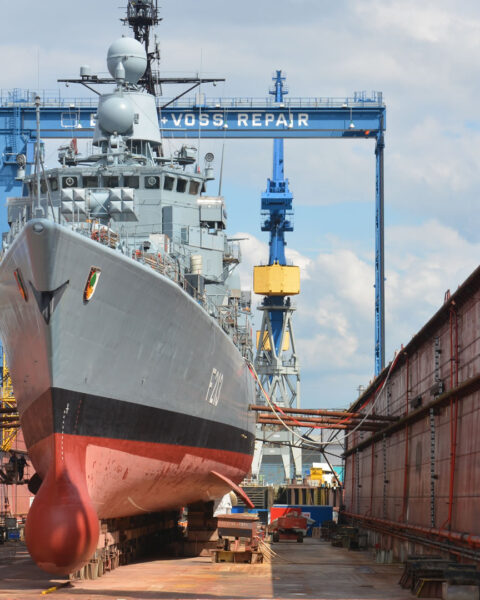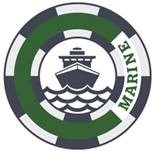
Ship owners and builders have always relied on dry docks in one form or another to enable the construction, maintenance and repairs of ships, boats and other vessels. Some dry docks are purpose built for the construction of ships whilst others are used for the repair and maintenance of vessels.
Here at Calvey Marine, we are the sole UK agents of Drydocks World Group, the PaxOcean Group and Lisnave Shipyard. Our team works with top companies and international drydocks and has excellent and established relationships with ship repair docks.
These dry docks have played an important role in ship building and repair over the course of history, allowing the construction of the Titanic and the essential repairs required to ships during the Second World War.
The Origins Of Dry Docks
The earliest dry docks are thought to have been built in the 10th century AD in China. Two dragon boats had been presented to the throne and came to the point where they needed repairing and maintenance. A basin was excavated in a lake and beams laid on pillars in the basin. This was then breached and the water flooded in, allowing the boats to enter. Once the boats were in position, the breach was sealed and the water removed using a system of wheels. They then received the maintenance they required and the process reversed to get them back on the water, the basin was then filled in.
In the 14th and 15th century, many ships were built on land and then dragged or pushed into the water using timbers. If repairs were required then boats were beached using tides and supported with earth and sand. Artificial banks were built to then prevent the next tide taking the vessel out until it been made sea worthy again. Some ships had fences or ‘hegge’ built around them to exclude the tides whilst undergoing maintenance.
Dry Docks in the UK
Henry VII commissioned the first English dry dock in 1495 which was built in Portsmouth, this was also one of the first dry docks in Europe and had gates sealed with puddle clay to keep the water out. This dry dock is still in use today at Her Majesty’s Naval Base, Portsmouth and is home to the oldest commissioned warship, HMS Victory. In fact, nearby Dry Dock No 9 was featured in the opening scene of the film Les Miserables where prisoners can be seen hauling a ship into dry dock.
By 17th century a number of dry docks had been built along the Thames to maintain the numerous ships now using the river for trade and transport, yet it was not until the early 19th century when steam pumping was introduced that the drainage of these dry docks became fully efficient.
176 ships were launched from Belfast between 1901 and 1912, one being perhaps the most famous ship of all time, The Titanic. This was the largest vessel ever constructed and the dry dock it was built in is a feat of Edwardian engineering. It could be pumped dry in an hour and a half, which is a rate of two swimming pools per minute. You can tour the dry dock today and walk along the keel blocks that The Titanic rested on.
World War Two and Dry Docks
The Second World War saw floating dry docks come into their own. They were used extensively by the American Army to create forward bases in the Pacific Ocean meaning the ships could be away from home and in action for long period of time. These temporary bases enabled ships to operate without a major port, providing a place for ships to be repaired, restocked and refitted. Ships damaged by enemy action go undergo essential maintenance without requiring a long and perhaps perilous journey back to the USA.
The Germans used fortified dry docks during World War Two to protect their ships and submarines from Allied attacks and even today, Navy vessels are usually constructed and repaired in covered dry docks to prevent spy satellites taking photographs whilst they are stationary.
Dry Docks Today
The largest roofed dry dock is located in Papenburg in Germany, owned by Meyer Werft and several large cruise ships have been built in the dry docks here. Hyundai own the biggest dry dock in the world which is situated in Ulsan, South Korea. This is 490m long, 115 m across and 13.5m deep.
One of the busiest shipyards in operation is Drydocks World in Dubai which has been running for over 30 years and has repaired over 7500 vessels in this time. This shipyard largely deals with ULCCs (Ultra Large Crude Carriers) and VLCCs (Very Large Crude Carriers), handling on average 350 vessels each year. Drydocks World recently received the “Best Repair Yard” Award at the 7th ShipTek International Maritime Awards and holds the record for servicing 42 vessels in addition to 11 rigs all at once, showing it is truly one of the world’s leading shipyards.
With 29 International shipyards represented across the globe, including shipyards in Canada, America, Europe, Middle East and China, Calvey Marine can assist you with dry docking your ship so it can be maintained and repaired, ensuring efficiency and keeping your fleet earning and operating. To find out more about dry docking, call us today on 01903 748860 or email calvey@calveymarine.co.uk.


